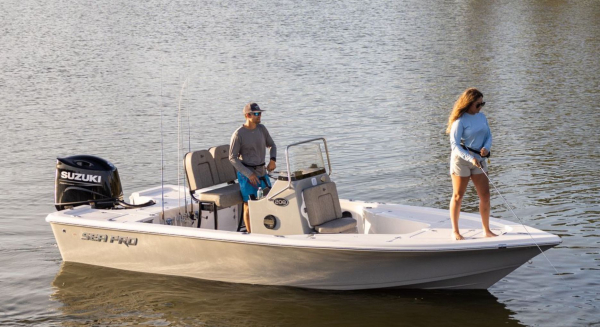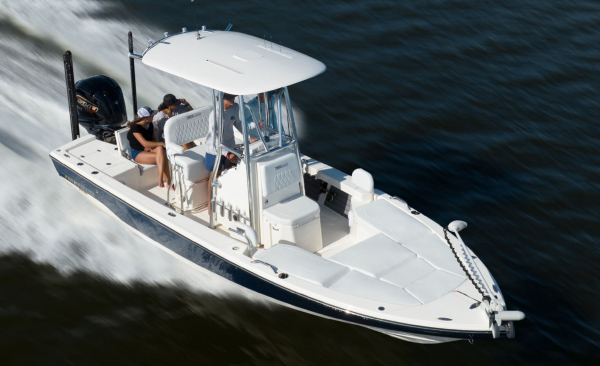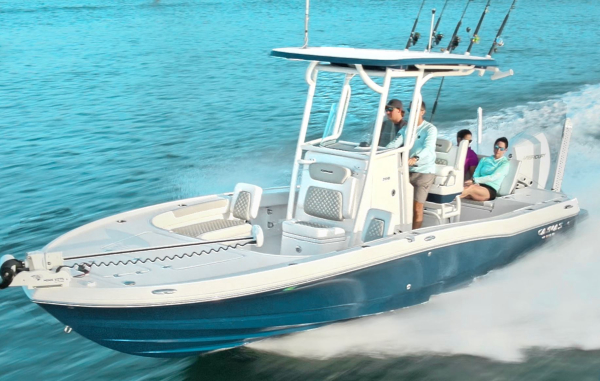
By Frank Sargeant
Frankmako1@gmail.com
Having spent most of my life testing, fishing and writing about fishing boats, I occasionally have somebody ask me to recommend a brand or a specific boat before they go shopping.
A recent case might be of interest to many readers who live on the East Coast or in the Southeast. We’ll confine the discussion to inshore center consoles, since those are the most popular and most affordable of coastal boats. A friend retiring and headed to South Carolina wanted an inshore bay boat that would also safely fish offshore at times. Here’s more or less what I told him:
First, I respect “name brand” boats but I don’t have to own one. Boats like Boston Whaler, Caymas, Contender, Everglades, Pathfinder and Scout definitely have the “Ahhh” factor—they are the Mercedes-class of the boating world.
They have the best upholstery, the best stainless steel fittings, the most accessories and often the most eye appeal. Some of them are made of carbon fiber or exotic FRP mixes, vacuum infused, to make them stronger and lighter.
For the vast majority of us, all of this makes no practical difference at all. Just like your Chevy, Ford or Nissan will get you to work just as well as a Benz, a Beemer or a Caddy, the extras are not all that important to basic function on a bay boat.
But there are a substantive reasons to invest the extra money—and it can be significant—to own one of these brands.

They cost more going in, true, but they also retain more of their value when it comes time to sell—and in boats, many of us are always looking for our “next” boat. They also sell quicker, in my experience—a lot of people search for the name brands, and those who do are more likely to have the cash to be buyers rather than lookers.
On the other hand, if you want a serviceable boat that you will use every weekend for 20 years, ride hard and put away wet, cover in fish slime and squashed sardines and not have to think about much in between, you can buy a whole lot of lesser-known brands for a whole lot less money and probably never regret your decision.
There are a few cautions, though.
I would not buy a boat put out by a new company. Although this makes it tough on entrepreneurs, it makes sense for buyers because a lot of boat builders come and go after just a few years in business. If you have a catastrophic problem like hull delamination early on, there might be no recourse with these brands.
Little-known brands will be more of a challenge to sell, and you’re less likely to get a decent price for them in terms of what you paid.
That said, if I wanted a basic bay boat these days, I’d look for a boat in the mid-price range. This is a center console between 18’ and 24’, with a draft somewhere under 18 inches motor up. (Boats 18’ and down and with a draft of 12” or less are considered true flats boats, great for two anglers chasing bonefish and reds in knee deep water but not good at all for fishing open water or for three anglers on most days.)

An 18-foot bayboat can fish 3 people who are careful, a 24 can fish 4, and you can rig these boats with a bow mount troller up front and fish anywhere from the back country creeks of New Jersey to the Carolina marshes to the flats of Tampa Bay and Charlotte Harbor.
You can also, on calm days, head out the inlet and catch stripers and blues north of Hatteras, bull reds and king mackerel to the south, maybe even dolphin and sailfish.
These boats are typically 8’6” wide, and have some flair at the bow as well as often an upswept bow. Deadrise is typically under 18 degrees—this not only lets them float shallow but also results in quicker planing on a well-balanced boat. (There are some inexpensive flat bottomed fiberglass and aluminum cc’s out there that will take you fishing very well inside on calm days, but these will beat your brains out in a chop—avoid them unless you always fish protected creeks and bayous.)
Most bay boats can be trailered by a mid-size truck like a Ford Explorer or Nissan Pathfinder (though as always in tow vehicles, bigger is better) and they’re easy for one-person launch with a bit of practice. Invest the little extra to buy an aluminum trailer—it’s impervious to salt, and the reduced weight also makes for easier towing. Get one with full size tires—never the little go-cart size, which wear out fast and also burn up bearings fast. Get bunk style, rather than rollers—much less trouble.
Outboards? Mercury and Yamaha are the big dogs and have dealers everywhere, so that alone makes them a good choice. Suzuki builds really good outboards but you’re lucky if you have a dealership close to your home base. If you have problems, it’s a long drive to get things fixed. Buy a motor big enough to easily plane the boat with your expected load aboard—a little more going in but well worth it.
There are a lot of mid-range boats in this class—Sea Pro is one I’ve run frequently on and off over the years with success, and their 2100 model is currently around $50,000 with a 150 Yamaha. That’s not chump change, but boats, unlike cars, can be financed over 10 years or even longer, and can be expected to outlast the payments. Blue Bay, Century, Cobia, Sportsman and others are in the more affordable class but well worth consideration.